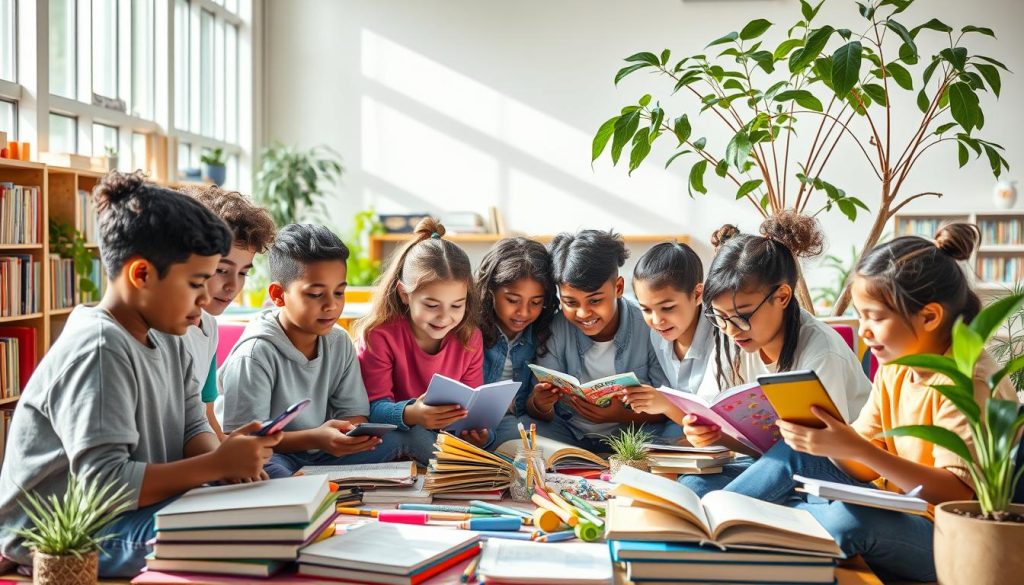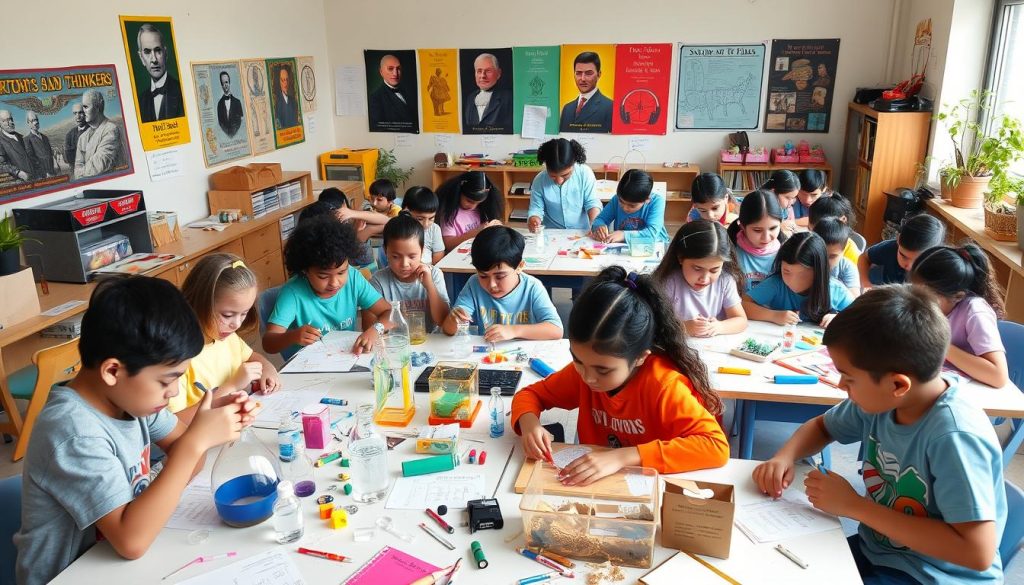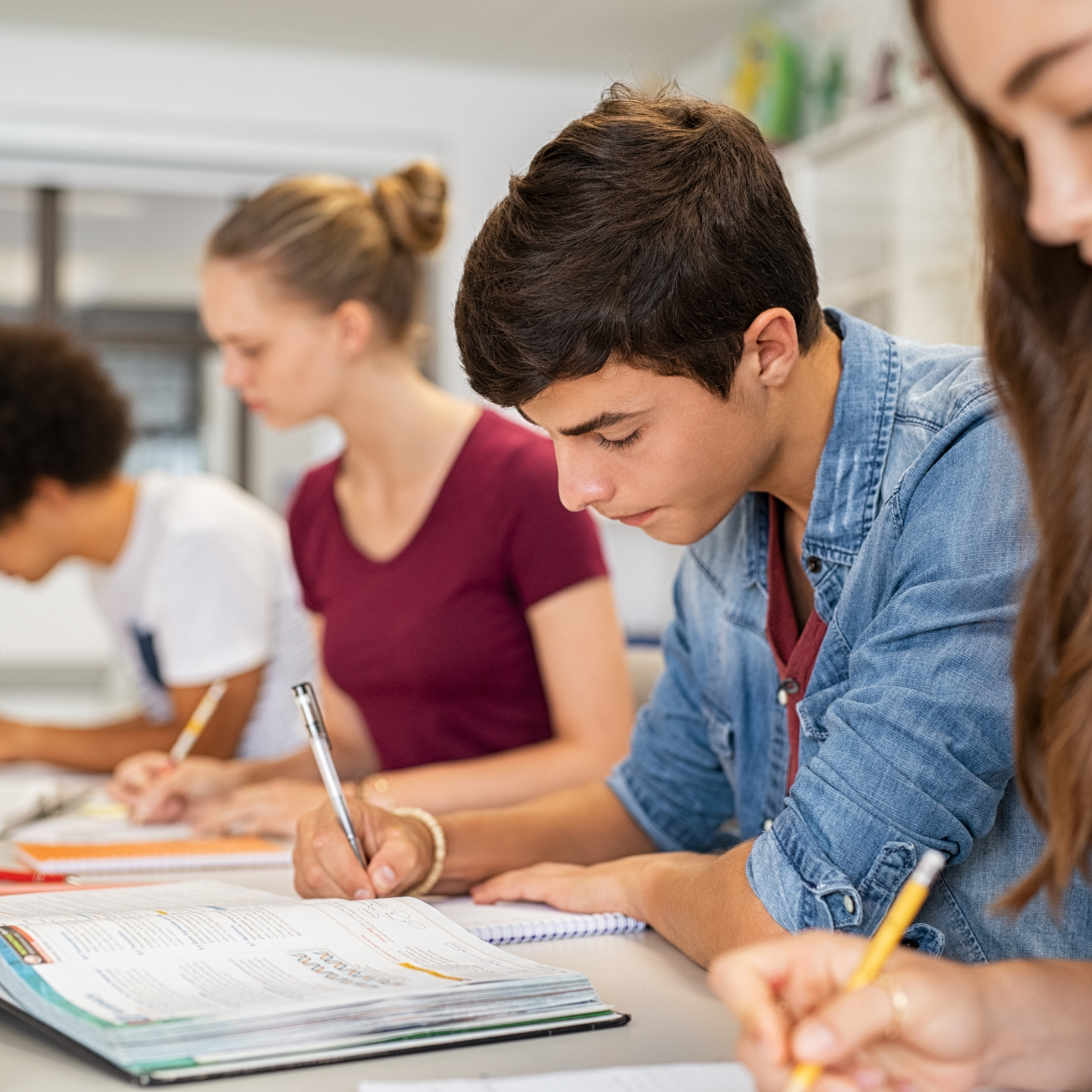In today’s fast changing education world, a new way of learning is taking over. It’s called self directed learning. But can students really learn subjects on their own without teachers? The answer might surprise you.
Self directed learning lets students control their learning path. It builds their independence, motivation, and understanding of the subject. By giving them tools and resources to learn at their own speed, we help them reach their full potential. This prepares them for learning throughout their lives. This method has proven it’s worth and it saves teachers from over working and stress with more passes in class.
Key Takeaways.
- Self directed learning helps students take charge of their education. This leads to better motivation and grades.
- Blended learning mixes online tools with personalized teaching. It helps students learn subjects without traditional classroom teaching.
- It’s important to support a growth mindset and give students choices that fit their level. This helps them become more independent and self motivated.
- Students learning on their own get better at managing time, solving problems, and talking to others. These skills help them succeed in college and later careers.
- For self directed learning to work well, we need to change how teachers and students work together. Teachers should help guide, and students should take an active role in their learning.

Nurturing Student Motivation Through Autonomy.
As students move forward in school, many start to lose their curiosity and motivation. But, research shows that giving them autonomy and choice can bring back their drive to succeed. By using their personal interests and offering developmentally appropriate choices, teachers can create a place where students learn on their own and with passion.
Provide Developmentally Appropriate Choices.
Teachers need to help students find their learning interests, strengths, and what they like. By giving them choices that fit their level, students can take charge of their learning. This leads to more engagement and motivation.
Tie Learning to Students’ Personal Interests.
When students get to pick topics they like, they become more curious and eager to learn. This personalized learning way boosts intrinsic motivation. It also helps students learn how to learn on their own.
| Strategies to Nurture Student Motivation | Benefits |
|---|---|
| Provide Developmentally Appropriate Choices | Increased engagement and motivation |
| Tie Learning to Students’ Personal Interests | Enhanced intrinsic motivation and self-directed learning |
“Autonomy support from educators predicts the level of engagement in the class. Autonomy support leads to more positive emotional, psychological, and behavioral outcomes for students.”
The Importance of Self Determination in Learning
Education shows us how crucial self determination is for student motivation and success. Self determination theory says that meeting students’ needs for autonomy, competence, and relatedness boosts their motivation to learn.
Teachers who support student freedom can really make a difference. For example, a study by Black AE and Deci EL (2000) showed that teachers who support student freedom help students in organic chemistry feel more in charge. This led to better grades and more effort in the class.
“Autonomy support in the classroom leads to benefits such as increased motivation and engagement, self regulation in learning, greater academic achievement, and increased self esteem and well being.”
Research by Wehmeyer ML et al. (2011) points out how important personal self determination is. A study by Abery BH and Stancliffe RJ (1996) also stressed the need for independence and choice for people with disabilities. This shows that everyone needs to feel in control.
A survey by Carter EW et al. (2008) looked at what high school teachers think about helping students feel more in charge. It showed how important this idea is to teachers.
Creating a classroom that values student autonomy helps students reach their full potential. It lets them take charge of their learning and builds a strong motivation to do well.
Creating an Inspirational Learning Environment.
In the face of an ongoing teacher shortages globally, educators are increasingly turning to innovative teaching methods to ensure that students continue to engage deeply with their learning. One highly effective approach that has gained traction is Project Based Learning (PBL). This dynamic instructional strategy empowers students to take charge of their education by immersing them in real world projects that foster critical thinking, collaboration, and creativity. Research consistently shows that PBL not only enhances student engagement but also leads to improved academic performance.
For instance, a study conducted by the Buck Institute for Education found that students engaged in PBL demonstrated significantly higher achievement levels compared to their peers in traditional learning environments. In a case study of a high school in California, students participating in a PBL curriculum outperformed their counterparts on standardized tests, showcasing remarkable gains in both math and literacy skills. Another compelling example comes from a middle school in New York, where educators implemented PBL across various subjects. The results were astonishing; students reported increased motivation and enthusiasm for learning, and their overall attendance rates improved dramatically.
Moreover, a review of multiple studies highlighted that students engaged in PBL not only retained knowledge longer but also developed essential skills such as problem solving and teamwork, which are vital for success in the modern workforce. These insights provide a powerful testament to the potential of PBL as a transformative educational approach, especially during times of teacher shortages when traditional methods may falter. By embracing project based learning, educators can create a vibrant and effective learning environment that inspires students to reach their fullest potential.
Making a learning space that inspires is key to helping students learn on their own and stay motivated. Educational expert Barbara McCombs found that a teacher’s way of managing the classroom matters a lot. She saw how a middle school teacher’s empowering style helped a lot.
An Inspirational Story: Motivate Students with Ownership.
McCombs saw a teacher who let his students decide how the classroom should be run. By making the rules together, the students felt they owned the classroom. They actually set stricter rules than the teacher would have.
This feeling of ownership made the students take charge of following the rules they made. This not only made the teacher respected but also made the students more focused and engaged. This story made McCombs and the teacher write a book called “Motivating Hard to Reach Students.”
Letting students play a big part in their learning space is a great way to boost intrinsic motivation and student centered learning. By letting students help manage the classroom, teachers can make students more committed to learning. This creates a more exciting and inspiring classroom.
“When students feel ownership over the classroom, they are more invested in their own learning and the success of their peers.”
Teachers Resources And Lessons Plan:
Master Subjects Without Teachers Through Blended Learning.
Technology is changing how we learn, making blended learning a key way for students to learn on their own. This method mixes online learning with in person help. It gives students more control over their learning and lets them find their own paths to success.
Reaching Students Through Increased Choices in Online Classrooms.
The old classroom setup often doesn’t give students much choice or interest. But blended learning changes that. With many online courses and interactive tools, students can take charge of their learning. This student autonomy makes them more engaged and proud of their learning.
Blended learning also means students can learn about things they really like. By mixing online tools with face to face help, teachers can make learning fit each student’s needs. This makes learning more personal.
| Feature | Description |
|---|---|
| Blended Learning | A mix of online and in person learning that gives students more choices and personalization. |
| Student Autonomy | Students get to play a bigger role in their learning, which makes them more engaged and responsible. |
| Personalized Learning | Learning is customized to fit what each student needs, likes, and is good at. |
But blended learning needs teachers who know how to use technology well. Teachers must pick the right digital tools and make sure they help students learn better, not worse.
“Blended learning gives students the best of both worlds , the flexibility and personalization of online learning, combined with the guidance and support of traditional classroom instruction.”
Developing Success Skills for Self Guided Learning.
Students aiming to learn on their own need to develop key success skills. The University of Chicago’s UChicago Consortium on School Research found five important factors for doing well in school. These include academic behaviors, perseverance, mindset, learning strategies, and social skills. These skills can be improved with the right learning environment.
Academic Behaviors and Perseverance.
For self guided learning, students need good academic behaviors. This means showing up to class, finishing homework on time, and taking part in class. Perseverance is also key. It helps students push through tough times and stay focused.
Positive Mindsets and Learning Strategies.
Having a positive mindset helps students stay motivated and resilient. They should believe they can get better and use good learning strategies. These include taking good notes, managing time well, and thinking about what they’ve learned. These skills help students learn on their own and keep learning throughout their lives.
| Success Skill | Description |
|---|---|
| Academic Behaviors | Consistent class attendance, timely assignment completion, active participation |
| Perseverance | Ability to overcome challenges and maintain focus |
| Positive Mindsets | Growth mindset, belief in ability to improve |
| Learning Strategies | Effective note taking, time management, self-reflection techniques |
Teachers can help students develop these success skills. By doing so, we make them more independent and in charge of their learning.
Empowering Students Through Rigorous Learning Opportunities.
Learning doesn’t just happen by staring at screens all day or filling out endless worksheets. To really speed up learning, we need to challenge students with tough, high level tasks. These tasks make them think and use what they’ve learned. Project based learning is a great way to give students rigorous, student driven learning opportunities. It shows them the value of their hard work and helps them take charge of their learning.
Studies show that how we teach in class can really shape how students think about learning. Teachers can teach students how to learn better, which helps them keep going and do well. It’s important to make students feel confident. When they feel confident, they keep trying, which leads to success.
The University of Chicago found five key factors that help students do well in school. These are things like staying focused, not giving up, and learning how to learn. Teaching students how to organize their time, think about their learning, and set goals are important. These skills help them stay on track and keep going when things get tough.
Project based learning like Project Leo is a great example of how this works. It’s a program for 256 students that uses AI to help them learn. Students get feedback from teachers, friends, and parents on their work. They also build portfolios of their projects during the day. This helps them show off their skills to colleges or employers, opening up more opportunities for them.
By giving students rigorous, student driven learning opportunities, we help them take control of their education. This prepares them for the challenges of the 21st century job market.
“The primary challenge for Project Leo is to gain the support of teachers and change the prevailing mindset towards personalized, relevant, and rigorous learning opportunities.”

| Project Based Learning Initiatives | Key Features |
|---|---|
| High Tech High (San Diego, CA) |
|
| Da Vinci Network (Los Angeles) |
|
Moving Beyond Grades: Fostering Intrinsic Motivation.
We need to see the downsides of focusing too much on grades. Feeling pressured by others can make us perform worse, limit our thinking, and make us less happy. Studies show that using grades as rewards can also hurt the kind of deep learning we want in school.
Trying to do well in school just for grades can make teens feel stressed, sad, and lose interest. Instead, we should aim to build intrinsic motivation, the drive to do things for their own sake. This is key for deep, meaningful learning.
The Problem with Focusing on Grades.
Students might not really get the material if they’re just in it for the grades. They might even cheat or just memorize things to get good scores. This shallow learning doesn’t prepare them for real life challenges outside school.
- Grades can stop creativity and critical thinking as students try to please teachers instead of following their interests.
- The need to get high grades can cause burnout, stress, and make learning less enjoyable.
- Too much focus on grades can also hurt the growth of important skills like perseverance, problem-solving, and a positive mindset.
To help our students and keep them loving learning, we need to move from grades to building intrinsic motivation and self-determination. This fits with self determination theory, which says that being in control, feeling competent, and feeling connected are key to doing well and being happy.
“The problem with grades is not that they’re objective, but that they are subjective, and often a poor measure of what really matters.”
Self Determination Theory and Student Motivation.
Helping students find their own motivation is key to their success in school and beyond. The self determination theory says that students need to feel autonomy, competence, and relatedness. This helps them want to learn and do well.
How to Boost Students’ Intrinsic Motivation.
Teachers can use different ways to help students want to learn on their own. These include:
- Taking students’ views and making learning relevant to them
- Letting students choose their interests and explain why tasks matter
- Understanding and accepting their feelings, using kind words, and being patient
Studies show that when students are motivated from within, they do better in school. This is especially true for African American and Latino students. But, research by Taylor et al. (2014) found that this motivation can drop over time. This happens because students may not feel their needs are being met.
| Subtype of Extrinsic Motivation | Description |
|---|---|
| External Regulation | Behavior is driven by external rewards or punishments |
| Introjected Regulation | Behavior is driven by internal pressures, such as guilt or shame |
| Identified Regulation | Behavior is valued and seen as personally important |
| Integrated Regulation | Behavior is fully assimilated into the self and aligned with one’s values |
Self determination theory says that when students feel they have autonomy, competence, and relatedness, they’re more motivated. By using strategies to boost their inner drive, teachers can help students reach their goals. This leads to success in school and life.
Project Based Learning for Student Empowerment.
Project based learning (PBL) changes the classroom power balance. It boosts students’ intrinsic motivation. Through real world projects, students take control of their learning and gain key skills.
PBL can make students more motivated and do better in school. Studies show that PBL students do better on tests and exams (Deutscher et al, 2021; Duke et al, 2020; Krajick et al, 2022; Harris et al, 2015). It also helps close achievement gaps and prepares all students for the future.
In PBL, students work together to solve real problems. This lets them make creative decisions and communicate well. They learn to give feedback and work independently. Presenting their projects to experts can spark new interests and passions.
| Benefits of Project-Based Learning | Evidence |
|---|---|
| Improved academic performance | Students in PBL classrooms outperform non PBL peers on state tests, AP exams, and college entrance exams (Deutscher et al, 2021; Duke et al, 2020; Krajick et al, 2022; Harris et al, 2015). |
| Enhanced 21st century skills | Students in New Tech Network schools show better teamwork, decision-making, critical thinking, and communication (Ancess & Kafka, 2020; Muller & Hiller, 2020; Zeiser, Taylor, et al, 2019). |
| Improved student engagement and motivation | PBL boosts student motivation and engagement when done well (Barnett et al, 2020; Hernández et al, 2019). |
By using project based learning, teachers help students become more self motivated. This prepares them for success in today’s world.

Building Trust and Emotional Safety.
Creating a positive and supportive classroom community is key to helping students learn on their own. When students feel safe and secure, they’re more likely to take risks and learn. Even if they fail, a supportive environment makes them want to try again.
Psychological safety is important in student teacher relationships and social emotional learning. It means feeling safe to take risks. By building trust, teachers help students be creative, work together, and do well in school.
- Clear rules make students feel safe to ask questions and get help, which helps them understand better and do better.
- Letting students share their feelings in a safe place helps them manage their emotions and learn about social skills.
- Class discussions where everyone feels safe to speak up create a place where everyone’s ideas are heard and valued.
When students feel safe, they can take risks, think positively, and do well on their own. Trust and feeling secure help make learning exciting, active, and successful.
“Psychological safety is a shared belief that the team is safe for interpersonal risk-taking. It is a climate in which people are comfortable being themselves.”
– Amy Edmondson, Harvard Business School
Shifting the Power Dynamic.
Changing classrooms from teacher focused to student led means a big change in how we think about learning. It moves from just following rules to giving students real power over their education. This means letting them make choices, take charge of their learning, and help decide what to do in class.
Teaching that respects students’ cultures is key. It helps students connect with what they know and think deeply. This change is vital for making students feel they truly own their learning, have control, and feel good about being in class.This is how we build leaders of the future.
“Culturally responsive teaching aims to engage students by relating learning to their past experiences and strengthening their sense of identity.”
Using what students already know, making lessons relevant, and valuing their cultural background are important steps. Teachers can also use diverse books and authors to make classes welcoming for everyone. This approach helps all students feel included and supported.
To change the classroom, teachers need to know and value the unique needs of all students. They must be ready to adjust their teaching to support a culture of student ownership, student agency, and inclusion. This change is key to giving students the power to learn and ensuring everyone has a fair chance to succeed.
Leveraging Student Interests and Curiosity.
In the world of student centered learning, using student interests and curiosity can change the game. When students get to explore topics they find interesting, they take a bigger role in their learning. This method boosts their intrinsic motivation and creates a personalized learning experience. This leads to deeper engagement and better grades.
Studies show that interested students attend class more, listen better, and do well in school. Interest drives learning and shapes their future paths. By using students’ curiosity, teachers can make learning exciting and empowering.
“Curiosity is the engine of achievement.”
– Ken Robinson, education expert
It’s important to really understand what students want and need. Teachers should ask them and create a culture of asking questions. This way, student centered learning grows, and trust and respect between teachers and students build.
Using students’ interests and curiosity makes learning fun and engaging. It helps students love learning for life. This method fits with personalized learning, focusing on each student’s unique needs and likes.
| Strategies to Leverage Student Interests and Curiosity |
|---|
|
Putting student interests and curiosity first can make student centered learning work its best. It leads to a more engaging, meaningful, and impactful learning experience for everyone.
Conclusion.
Empowering students to learn on their own changes how we see teaching. It moves from just following rules to giving students real power over their learning. This means boosting their intrinsic motivation by giving them control, teaching them to succeed by themselves, and offering tough challenges they can lead.
Teachers should focus more on making students want to learn for themselves, not just for grades. This way, students feel more motivated to learn.
Building a supportive and safe classroom is crucial for students to take charge of their education. This approach helps students become skilled at learning by themselves. It prepares them to keep learning and growing throughout their lives.
Changing how classrooms work is key to letting students take full control of their learning. By doing this, teachers help students reach their full potential. They become self directed and motivated to do well in today’s changing world.
FAQ.
How does motivation relate to students having opportunities for autonomy and academic choices?
Studies show that motivation links to students having control and making academic choices. This gives students a sense of power and control over their learning. It helps them feel responsible and motivated.
What are the benefits of providing students with more choices and control over their learning?
Giving students choices makes them more likely to take charge of their learning. It also boosts their curiosity and desire to learn. This approach makes learning more engaging and meaningful.
What is the connection between student motivation and Self Determination Theory?
Self Determination Theory says that students need to feel in control, competent, and connected to learn well. Teachers can boost motivation by listening to students, letting them choose topics, and explaining learning goals.
Can you provide an example of how a teacher empowered students to take ownership over their learning?
In a middle school, a teacher gave students control over classroom rules and choices. Students set strict rules for themselves, showing they felt in charge. This approach inspired the author to write about motivating hard to reach students.
How can increased technology use in classrooms impact student control and engagement?
More technology in classrooms means students need more control over their learning. Using tech can make learning more engaging, but teachers must be well trained to use it effectively.
What are the noncognitive factors that impact student academic success?
The University of Chicago found five key factors that affect student success: behavior, perseverance, mindset, learning strategies, and social skills. These skills can be developed in the classroom.
How can project based learning help empower students and nurture their intrinsic motivation?
Project based learning tackles real world problems and lets students make choices. It shifts the classroom power balance, boosting students’ motivation. Students learn to work together and give constructive feedback, moving away from teacher control.
What are the potential drawbacks of an exclusive focus on grades as a motivator?
Focusing too much on grades can harm students’ performance and well being. It can make them feel anxious, depressed, and unmotivated at school.
How can teachers create a positive and supportive environment to empower students as self directed learners?
Teachers should make classrooms safe and supportive to empower students. When students feel safe, they’re more likely to take risks and learn. A supportive environment encourages them to try again even after failure.
How can teachers shift their classroom philosophy to empower students?
Teachers can move from a teacher centered to a student centered approach. This means giving students more choices, responsibility, and a say in decisions. It helps them become active learners instead of just listening.
